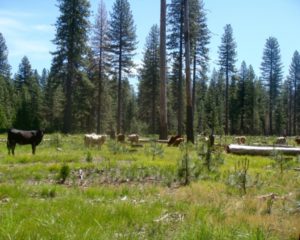The Mt. Shasta Wild cattle herd is able to forage thousands of unfenced acres of diverse plant species, not just a mixture of pasture grasses. Forage includes but is not limited to: native grasses, bitter brush, sagebrush, rabbitbrush, manzanita, serviceberry, mushrooms and ferns. During the summer the Mt. Shasta Wild cattle herd drinks Mt. Shasta’s glacial water that runs off the mountain and in the winter they drink well water that has been filter through ancient lava rock from Mt. Shasta’s eruption adding to their mineral nutrition. They eat and drink like elk and deer do. This gives the Mt. Shasta Wild Beef a unique regional flavor and is what increases their nutritional value.
Late spring as the snow melts, the cattle migrate to the base of Mt. Shasta for the summer with little assistance; then naturally migrate back to the historic homestead for the winter. This makes a very small carbon footprint in comparison to many grass fed beef operations that ship their cattle by truck to different regions to keep them on grass. Organic and grass fed products do not automatically mean they are environmentally friendly.
Mt. Shasta Wild does not use artificial methods to stimulate growth or prevent disease. No exposure to hormones, antibiotics, chemical dewormer or vaccinations make our wild fed primal beef safer and more natural than organic, especially industrial organic products. We are able to accomplished this because the cattle herd is small compared to the expansive acreage they graze; we average 1 cow/calf pair per 180 acres. Less concentration means less disease and parasites. There is also thought to be natural compounds in some of the brush they forage on that naturally prevents parasite problems.
Allowing cattle to naturally select what they need to eat in order to receive optimum nutrition and maintain good health creates a complex nutritional richness which in turn creates a complex, unique, regional flavor. Michael Pollen discusses this in part two of his book, “In Defense Of Food”. His literature review of Weston A. Price’s research concluded that the common denominator of health was to eat a traditional diet of fresh animals and plants grown on soils that were themselves rich in nutrients. Much of the range the Mt. Shasta Wild cattle graze on is natural untouched ground full of diverse micro-organisms. The mici-organisms are then transferred to the plants which transfers to healthier fats (more omega-3s and fewer omega-6s and saturated fat), as well as, higher levels of vitamins and antioxidants. Unlike conventional farming that relies on a monoculture that uses artificial fertilizers and pesticides to keep the land producing leaving it void of micro-organisms.
In part three of “In Defense Of Food”, Michael Pollen’s eater’s manifesto encourages eating wild foods when you can but hesitates to recommend this because of the scarcity of wild game. This is where the Mt. Shasta Wild foraged beef comes in, it is the closest thing you can get to eating wild elk and differs from other grass fed beef on the market.

